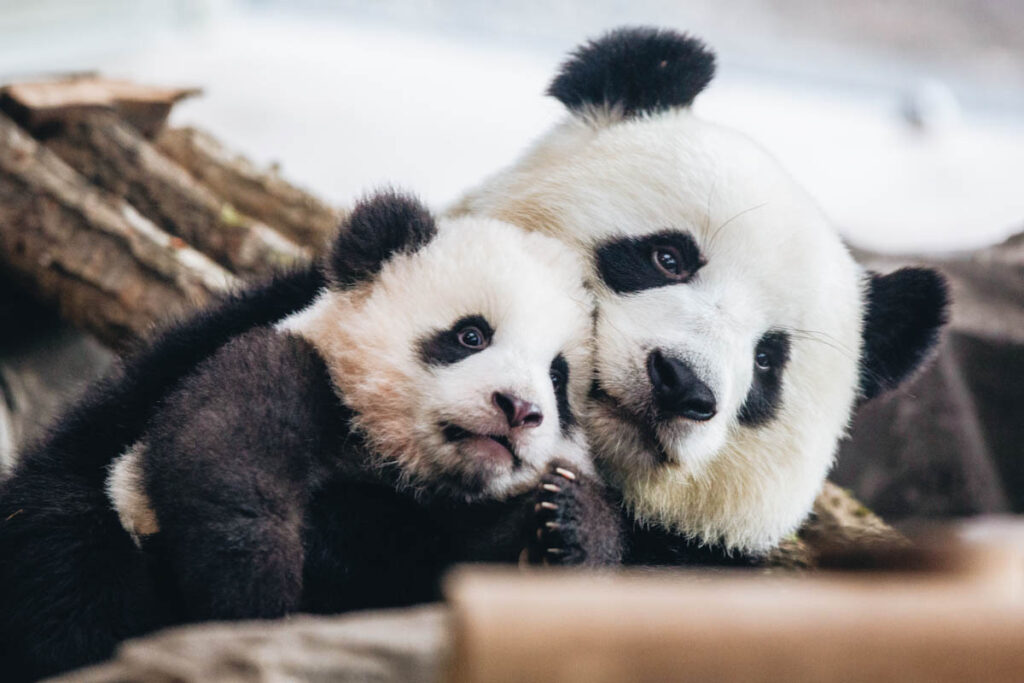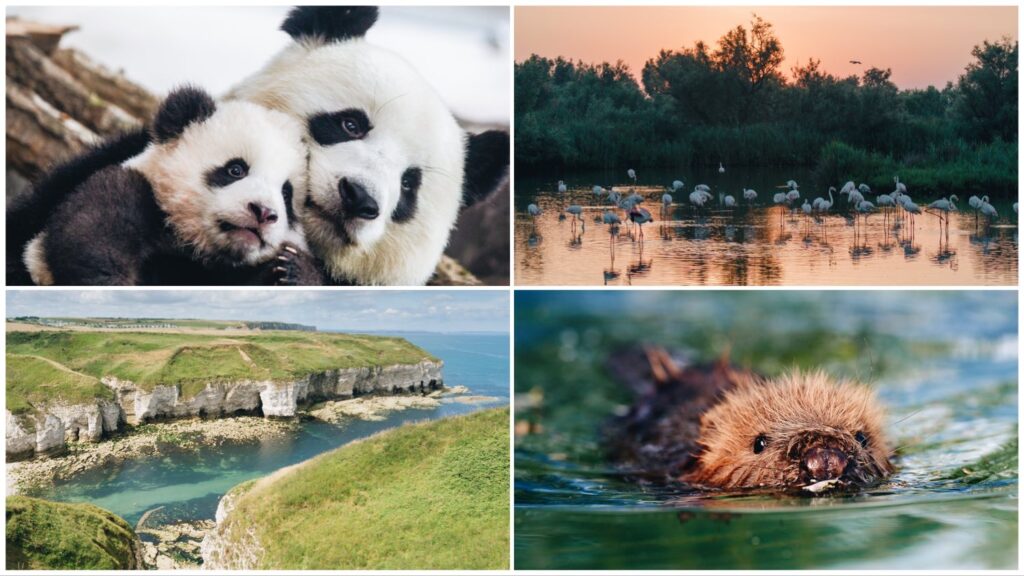We almost can’t believe it, but giant pandas are officially no longer endangered. After nearly 40 years, the world’s favorite black and white bear is making its long-awaited comeback. Plus, one of the worst energy decisions in U.S. history is finally dead in the water, and biodiversity is doing a victory lap. This week’s dose of good environmental news is well worth celebrating.

Exmoor Has Its First Baby Beaver in Nearly Half a Century
The good news: Rangers just spotted the first baby beaver, or “kit,” to be born on Exmoor in around 400 years. The tiny six-week-old animal lives on the Holnicote Estate, Somerset. They first appeared on camera swimming with their mother back to the family’s lodge. Shortly thereafter, the British public voted to name the kit after beloved England footballer Marcus Rashford.
The birth of Rashford follows the successful reintroduction of two Eurasian beavers—the animal’s parents—to the site in 2020. Beavers were previously native to the UK before they were hunted to extinction for their pelts, glands, and meat. Rangers from the estate reported that the young beaver and their family are “thriving.”
The impact: Beavers are “ecosystem engineers,” and this colony has completely transformed their new home. Over the last year, their damn building has turned it into an open wetland area. This benefits birds, bats, bugs, and even otters. The birth of a kit confirms that Exmoor’s new generation of beavers are here to stay, and a record number of animals will be reintroduced nationwide throughout 2021.
Did you know: Beavers are a keystone species and help to prop up their entire ecosystem, as shown by Rashford and their family. The amphibious mammals are descended from castoroides and trogontherium—huge, bear-sized animals that lived in North America and Europe during the ice age. Modern beaver dams can grow to hundreds of meters in size in the wilderness if left intact. It is likely that generation after generation work to maintain such enormous lodges.
How you can help: There are a wide number of beaver-focused wildlife charities currently operating in the UK that could use additional support. They include the Beaver Trust, the Wildlife Trust, Cornwall Beaver Project, and the Scottish Wild Beaver Group. To learn more about beavers, read Rewilding Britain’s informative post here.

The UN Just Set a Historic Plan For Biodiversity
The good news: A brand-new plan by the UN could step up environmental protection worldwide. As per the plan, governments must safeguard at least a third of the world’s oceans and land by 2030. This is essential if we are to prevent further catastrophic biodiversity loss. The suggestion is just one part of the new Global Biodiversity Framework (GBF), a Paris Agreement-style effort to halt natural destruction.
The impact: Scientists predict that a sixth mass extinction event is currently in progress, and ineffectual national efforts are failing to take decisive enough action. The GBF could help halt biodiversity loss by eliminating plastic pollution, reducing pesticide use, and radically overhauling food production. This marks the first tangible attempt to make ambitious biodiversity goals that look beyond 2020. (It’s worth noting that no governments managed to meet any of the previous targets.)
Did you know: The issues of biodiversity, land degradation, and climate change are all inextricably linked. Protecting what remains of the world’s ecosystems will help to mitigate climate change, which in turn will help to protect additional flora and fauna from global warming (including the recently endangered panda bear). Addressing these issues in a meaningful way, as suggested by the UN, is the only way forward.
Jessica Dempsey at the University of British Columbia, Canada, told NewScientist that “governments will also have to deal with the structural inequalities in the economic system”—specifically the way in which rich countries have benefited most from (and are most responsible for) the industry and emissions behind biodiversity loss.
How you can help: As noted by Dempsey, the responsibility for halting biodiversity loss rests with the governments, corporations, and billionaires of the world, rather than individuals.
That said, we can all make a difference to the natural world through the choices we make. Planting local wildflowers, fruit, and vegetables helps to promote biodiversity, as does encouraging pollinator health. Buying locally, where possible, also makes a big difference. Check out LIVEKINDLY’s guide to zero waste gardening here, and learn more about protecting bees here.

The UK Will Trial Long-Awaited Marine Protections
The good news: The British government has announced that it will ban fishing and other environmentally harmful practices. The trial will take place in at least five carefully selected marine environments just off the coast. The announcement follows an independent Benyon review of the case for HPMAs, and NGO Oceana’s calls for a supertrawler ban. Oceana recently found that the devastating fishing vessels spent over 68,000 hours operating in existing Marine Protected Areas (MPAs) in 2020.
The impact: “Highly Protected Marine Areas” (HPMAs) could help to eradicate harmful practices such as supertrawling in biodiverse and ecologically important areas of the UK’s languishing oceans. However, critics have pointed out that better enforcement of existing legislation would be more effective than new and “improved” restrictions. According to the Guardian, Greenpeace UK’s oceans campaigner Chris Thorne said that the scheme represents “a small step in the right direction” that will need scaling up considerably.
Did you know: The UK isn’t exactly world-renowned for its seaside vacations. But the stark and often beautiful British coastline supports a diverse range of important flora and fauna. Wildlife includes dolphins and whales, porpoises, seals, sharks, seahorses, turtles, and seagrass (an incredibly important climate sink). While the government has historically failed to protect the country’s unique natural resources, a recent study showed that up to 94 percent of Brits understand the importance of marine protection and would prefer decisive action.
How you can help: There are a huge number of charities working to protect the UK’s oceans, including Surfers Against Sewage, Ocean Conservation Trust, Marine Conservation Society, and Plastic Oceans. Here are five small things you can do today to help the ocean.

The Keystone Pipeline Is Dead!
The good news: After over a decade of lobbying, campaigning, and protests, the Keystone XL pipeline project is officially over. Designed to carry oil from Alberta, Canada to Steele City, Nebraska, the completed project would have joined an existing pipeline. While former U.S. president Barack Obama’s administration halted construction in 2015, former president Donald Trump later overturned that order. Most recently, current president Joe Biden revoked a permit needed to construct one section of the enormous project, thereby dealing the Keystone XL a decisive final blow.
The impact: The First Nations communities of Northern Alberta, environmentalists, and countless others opposed the Keystone pipeline. This is primarily due to its impact on proximate communities through leaks, pollution, and the destruction of indigenous land. But the project also came to represent the broader energy future of the U.S. in general and its struggle to divest from existing (and future) fossil fuel infrastructure. As with the Dakota Access Pipeline, the policing of protestors was extreme and has received international criticism.
Did you know: Since the mid 1980s, pipeline accidents are responsible for approximately 3 million gallons-worth of spills every year, or 200 barrels per day. The cancellation of the project has undoubtedly prevented a significant amount of environmental damage throughout North America and nationwide.
How you can help: While the Keystone pipeline project is over, other struggles continue. You can donate to support the Standing Rock protestors here, and sign petitions or donate to support the ongoing Stop Line 3 protests here. To contribute to the Line 3 Legal Defense Fund, visit the Pipeline Legal Action Network here.

Giant Pandas No Longer Endangered
The good news: According to Chinese officials, giant pandas are now classified as “vulnerable” rather than endangered. This follows decades of conservation and four separate censuses to ascertain population numbers. According to the Ministry of Ecology and Environment, protection methods include setting up reserves, relocation, training local rangers, and captive breeding. Making pandas no longer endangered has taken a varied and comprehensive approach to conservation.
The impact: According to the most recent census (carried out in 2013), 1,864 pandas now live in the wild. That’s an increase of more than 250 individuals since the previous census 10 years prior. Giant pandas help keep their habitat healthy. Where they live—exclusively in south central Chinese mountains—also has some of the highest biodiversity in the world. The slow and steady recovery of endangered pandas is a huge win for conservation, and for climate change. But it’s also good news for the wide variety of other rare and threatened species that share the same habitat.
Did you know: These bespectacled bears have captured the world’s imagination with good reason. Pandas really do spend 10-16 hours every day eating, and their diet does primarily consist of bamboo. According to the WWF, they need at least two distinct species of bamboo within their habitat for survival. Just one percent of their diet consists of other foods such as pumpkin, kidney beans, and wheat. Pandas are solitary, and despite their visual and physiological similarity to raccoons, they are definitely categorized as true bears. Human-caused habitat destruction was the main cause of the panda’s recent endangered status.
How you can help: While giant pandas might be out of the woods, they are still a vulnerable species. Organizations such as Pandas International and of course, the WWF, are working hard to protect both pandas and their surroundings. You can even “adopt” a panda here.
Looking for more positive news stories? Read the previous selection here.


